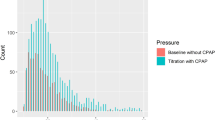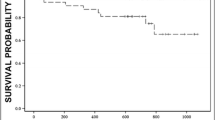Abstract
Purpose
The aim of our study is to determine the association between the pulsatility index (PI), a surrogate of cerebral small vessel disease and sleep-disordered breathing (SDB).
Methods
We conducted a transcranial Doppler ultrasound (TCD) study of 19 consecutive patients free of stroke and cardiovascular disease, referred for the evaluation of SDB. TCD was performed by a certified technologist. Subsequent polysomnography was performed according to the practice parameters of the American Academy of Sleep Medicine. We evaluated the association between the apnea–hypopnea index (AHI), the oxygen nadir, the blood flow velocities, and the Gosling PI, for the middle cerebral artery. We performed Spearman's rank correlation and nonparametric regression to evaluate the relationship between AHI, oxygen levels, and the PI.
Results
Median age was 48 years (range 37–83), with 52 % male sex (n = 10), and median BMI of 29.9 (range 25–40.4). The median AHI was 16.4 (0.2–69). The median PI was 0.97 (0.72–1.89) cm/s. The PI correlated with the AHI (rho = 0.44; p = 0.004) and with age (rho = 0.57; p = 0.001). Nonparametric regression adjusting for age showed a positive association between the AHI and the PI (standardized estimate = 0.88; p = 0.002). There was no relation between the oxygen nadir and the PI.
Conclusion
We observed increased PI in patients with SDB during wakefulness. The PI could potentially be an estimate of cerebral small vessel disease in patients with SDB and hence allow evaluating cerebral hemodynamics during wakefulness with a clinically relevant device.

Similar content being viewed by others
References
Redline S, Yenokyan G, Gottlieb DJ, Shahar E, O'Connor GT, Resnick HE, Diener-West M, Sanders MH, Wolf PA, Geraghty EM, Ali T, Lebowitz M, Punjabi NM (2010) Obstructive sleep apnea-hypopnea and incident stroke: the sleep heart health study. Am J Respir Crit Care Med 182:269–277
Minoguchi K, Yokoe T, Tazaki T, Minoguchi H, Oda N, Tanaka A, Yamamoto M, Ohta S, O'Donnell CP, Adachi M (2007) Silent brain infarction and platelet activation in obstructive sleep apnea. Am J Respir Crit Care Med 175:612–617
Gosling RG, King DH (1974) Arterial assessment by doppler-shift ultrasound. Proc R Soc Med 67:447–449
Somers CJ, Millar BC, Xu J, Moore DP, Moran AM, Maloney C, Keogh B, Murphy PG, Moore JE (2003) Haemophilus segnis: a rare cause of endocarditis. Clin Microbiol Infect 9:1048–1050
Epstein LJ, Kristo D, Strollo PJ Jr, Friedman N, Malhotra A, Patil SP, Ramar K, Rogers R, Schwab RJ, Weaver EM, Weinstein MD (2009) Clinical guideline for the evaluation, management and long-term care of obstructive sleep apnea in adults. J Clin Sleep Med 5:263–276
Alexandrov AV, Sloan MA, Wong LK, Douville C, Razumovsky AY, Koroshetz WJ, Kaps M, Tegeler CH (2007) Practice standards for transcranial doppler ultrasound: part i—test performance. J Neuroimaging 17:11–18
Stone CJ (1985) Additive regression and other nonparametric models. Ann Stat 13:689–705
Sabayan B, Jansen S, Oleksik AM, van Osch MJ, van Buchem MA, van Vliet P, de Craen AJ, Westendorp RG (2011) Cerebrovascular hemodynamics in alzheimer's disease and vascular dementia: a meta-analysis of transcranial doppler studies. Ageing Res Rev 11:271–277
Balfors EM, Franklin KA (1994) Impairment of cerebral perfusion during obstructive sleep apneas. Am J Respir Crit Care Med 150:1587–1591
Lee KY, Sohn YH, Baik JS, Kim GW, Kim JS (2000) Arterial pulsatility as an index of cerebral microangiopathy in diabetes. Stroke 31:1111–1115
Xiong YY, Mok V, Wong A, Leung T, Chen XY, Chu WC, Soo Y, Fu JH, Ding D, Hong Z, Wong KS (2011) Evaluation of age-related white matter changes using transcranial doppler ultrasonography. J Neuroimaging. doi:10.1111/j.1552-6569.2011.00649.x
Lee KO, Lee KY, Lee SY, Ahn CW, Park JS (2007) Lacunar infarction in type 2 diabetes is associated with an elevated intracranial arterial pulsatility index. Yonsei Med J 48:802–806
Young T, Peppard PE, Gottlieb DJ (2002) Epidemiology of obstructive sleep apnea: a population health perspective. Am J Respir Crit Care Med 165:1217–1239
Wallace DM, Ramos AR, Rundek T (2012) Sleep disorders and stroke. Int J Stroke. doi:10.1111/j.1747-4949.2011.00760
Buysse DJ, Hall ML, Strollo PJ, Kamarck TW, Owens J, Lee L, Reis SE, Matthews KA (2008) Relationships between the Pittsburgh Sleep Quality Index (PSQI), Epworth Sleepiness Scale (ESS), and clinical/polysomnographic measures in a community sample. J Clin Sleep Med 4:563–571
Jimenez-Correa U, Haro R, Gonzalez-Robles RO, Velazquez-Moctezuma J (2011) How is the Epworth Sleepiness Scale related with subjective sleep quality and polysomnographic features in patients with sleep-disordered breathing? Sleep Breath 15:513–518
Nieto FJ, Young TB, Lind BK, Shahar E, Samet JM, Redline S, D'Agostino RB, Newman AB, Lebowitz MD, Pickering TG (2000) Association of sleep-disordered breathing, sleep apnea, and hypertension in a large community-based study. Sleep heart health study. JAMA 283:1829–1836
Rasche K, Keller T, Tautz B, Hader C, Hergenc G, Antosiewicz J, Di Giulio C, Pokorski M (2010) Obstructive sleep apnea and type 2 diabetes. Eur J Med Res 15:152–156
Behrens S, Spengos K, Hennerici M (2002) Acceleration of cerebral blood flow velocity in a patient with sleep apnea and intracranial arterial stenosis. Sleep Breath 6:111–114
Virtanen J, Noponen T, Salmi T, Toppila J, Merilainen P (2012) Impaired cerebral vasoreactivity may cause cerebral blood volume dip following obstructive sleep apnea termination. Sleep Breath 16:309–312
Reichmuth KJ, Dopp JM, Barczi SR, Skatrud JB, Wojdyla P, Hayes D Jr, Morgan BJ (2009) Impaired vascular regulation in patients with obstructive sleep apnea: effects of continuous positive airway pressure treatment. Am J Respir Crit Care Med 180:1143–1150
Terborg C, Gora F, Weiller C, Rother J (2000) Reduced vasomotor reactivity in cerebral microangiopathy: a study with near-infrared spectroscopy and transcranial doppler sonography. Stroke 31:924–929
Author information
Authors and Affiliations
Corresponding author
Rights and permissions
About this article
Cite this article
Ramos, A.R., Cabral, D., Lee, D.J. et al. Cerebrovascular pulsatility in patients with sleep-disordered breathing. Sleep Breath 17, 723–726 (2013). https://doi.org/10.1007/s11325-012-0748-5
Received:
Revised:
Accepted:
Published:
Issue Date:
DOI: https://doi.org/10.1007/s11325-012-0748-5




